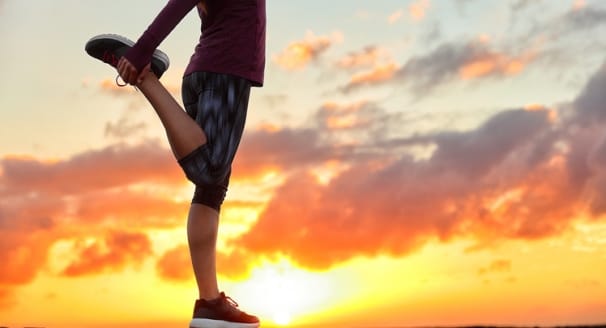All great athletes know the benefits of stretching to optimize athletic performance; however this crucial practice can sometimes be forgotten or neglected in the average workout regimen. If you are working towards some specific workout goals for weightlifting or sports consider adding a stretching routine for before or after your workout (depending on whose professional opinions you adhere to) to increase your range of movement. If nothing else, stretching can be great to reduce your incidence of injury. Do not worry about your current level of flexibility as the goal of stretching is to improve upon your current range of motion. Watch your progress and be amazed once you consistently add stretching to your fitness repertoire.
1. Lunges
Target your entire lower body with lunges. They work calves, quadriceps, hamstrings, glutes, and abdominals. Ensure your knee does not extend in front of your feet for proper posture and keep your back neutral to work the correct muscle groups. A favorite stretch for runners and weigh-lifters for good reason, this multi-tasking stretch with keep your physique balanced.
2. Triceps
The triceps muscle runs along the back of the upper arm and it is important to stretch this muscle as it counterbalances the more dominant bicep on the front of the arm. Avoiding tightness in the arms is key to having great reach and loose swings in sports like tennis and golf.
3. Wrists
Avoid carpal tunnel by stretching the wrist flexor regularly. The wrists are an essential joint to keep strong to avoid injury in racket sports, golf and baseball as the shock of impact can travel up the arm.
4. Quadriceps
Increase leg circulation and prevent cramping by stretching both quadriceps before and after intense sports like running and soccer. A flexible quadricep will help to avoid tightness in your legs so pull your shin into your pelvis and point your knee to the ground and feel the release of tension.
5. Calves
Lengthen your calf muscle with extension stretches, which also stretch the foot and ankle and avoid foot pain as the calf’s main job is to help in putting the foot down. Stretching the calf will also assist in avoiding Charlie horses, which is a buildup of lactic acid in the calf muscle.
6. Hamstrings
Hamstrings help you to extend your leg behind you and stretching the three hamstring muscles can alleviate discomfort lifting your leg and radiating back pain associated with tightness.
7. Hips
Stretching your hip flexor keeps your pelvis and thighs in alignment, which is essential for optimal running form and speed.
8. Groin
Performing groin stretches will loosen the adductor muscles, which are responsible for thigh and groin flexibility. To have good range of motion in your legs and elude injury your groin needs to remain loose.
9. Shoulders
The shoulders are vital for good reach and help you to lift objects. Increasing shoulder flexibility will help with shoulder strength.
10. Neck
The neck has the important job of carrying the weight of the head, which means it’s susceptible to tension and pain. Neck stretches mitigate strain and muscle spasms and ensure that the range of motion of the head is maintained

